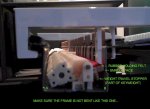John,
After attaching the 2nd pressure ribbon to the pins under the Mod Wheel, and hooking everything back up, the pressure on the White keys still did not work.
My Kurzweil is dismantled again, as I type this.
Did you say that you thought the pressure strip would work, regardless of which way the plug was connected?
Also, what do you know about Pressure ribbons? How do they work? Is it possible the ribbon itself is defective (doubtful, but maybe?), or is it really critical to have it placed Just Right at precise point location(s) under the sticky felt beneath the white keys? Again, I don't think my ribbon has moved, but the more information I have, the better.
Dementedchord, any ideas on the Pressure Ribbon on my white keys not working, even after having connected it once?
At this point, I'm just going to try reconnecting the ribbon to the pins, but with the connector flipped around 180 degrees.
Hi Toddskins,
Sorry to hear the aftertouch ribbon still isn't working. As I mentioned, the connector on mine was hooked on backwards but still worked. I don't think there's any dangerous control voltage that will short out if the ribbon is not plugged in right. However, avoid trying to conenct it by skipping pins, I dunno what that would do. Your best bet at this point is to try to connect it reversed to what it is at the moment. You might also want to check out the wiring harness that connects the modwheel & pitchbend & ribbon pc board to the other boards in the K2500. Another test is to connect the white keys ribbon (not working) to the black keys connector (working), to see if it is the ribbon or the input connector or circuit that has the problem.
As far as I can tell, the ribbon seems to just be a very long capacitor. there are 2 conductive strips with a sort of "S" pattern to them, (with a layer of thin insulation between them - I don't know, but if it is capacitive, there would be a layer of insulation). When the key is pressed hard, an area of the "S" pattern on the topside of the ribbon is put closer to the "S" pattern on the underside, thus the capacitance varies. The more keys are pressed, the more the capacitor value changes. If the ribbon is strictly resistive, it would be the same idea - the more "S" shapes that touch each other, the resistance value changes. The way to measure this is with an ohmmeter that also has capacitance measurement capabilities.
I noticed you have to press the keys really hard to get any pressure reading on the diag screen, press and hold, press further just to check if any reading at all on the diag screen.
Placement of the ribbon is important - it cannot move much anyways as it is glued and sandwiched between rubber padding and then the felt running all along underneath each row of keys, black or white.
The ribbon is fragile so check if it is not broken, especially at the connector end. If the ribbon is very bent anywhere, it is possible it may be broken. Check the opposite end too, all the way at the right of the keybed and make sire it is not shorted against the casing or the 2 layers shorting each other. Another test to do: hook the ribbon up and power on the K2500 & set it to the diag screen. Press C0 key. No data ? test over, there's a problem from that key all the way to the circuit chip. If there is data, keep going up the keyboard. As soon as you lose aftertouch data, backtrack until you get some. When the data resumes you found the break in the ribbon!
Did you notice there are a few trimmer potentiometers on that PC board ? I don't know if they are to calibrate or offset the wheels or if they affect aftertouch info. You could play with them but be sure to note EXACTLY where they are set currently so as to return to that position in case these pots don't affect the ribbon. Would be a good idea to recheck that the wheels are behaving properly afterwards too - those pots are old and probably scratchy by now... Oh I wish I had a schematic and service manual for the unit. If I ever find one, I'll make sure to share it with you

I never noticed if the ribbon did much difference when playing piano or organ patches. I did find this tidbit of information, which says that aftertouch data can also enhance expression...
"Some keyboards respond to additional pressure on a key subsequent to the initial note-on action. Often used for vibrato etc. You can't emulate aftertouch in software - it has to be a function of the physical keyboard in order to be present."
and
"Manufacturers seem to be taking it out more and more, its like we are going backwards. you'd think that by now channel aftertouch would be obselete because everything would have poly aftertouch.
I use aftertouch all the time but I only discovered it because my TR had it. Imagine all the people who don't use it because they don't know what it is. It adds an essential extra dimension for any performance synth.
I was quite offended in a lecture a while back, on MIDI, where the lecturer said "and then there's the poly aftertouch message. like the channel aftertouch, its a bit pointless as no-one uses it, they could have used the message type for something more useful"."
An interesting and really good thread on how & what aftertouch does:
http://forums.musicplayer.com/ubbthreads.php?ubb=showflat&Number=1744405
I hope this helps a bit!
John
Last edited:


